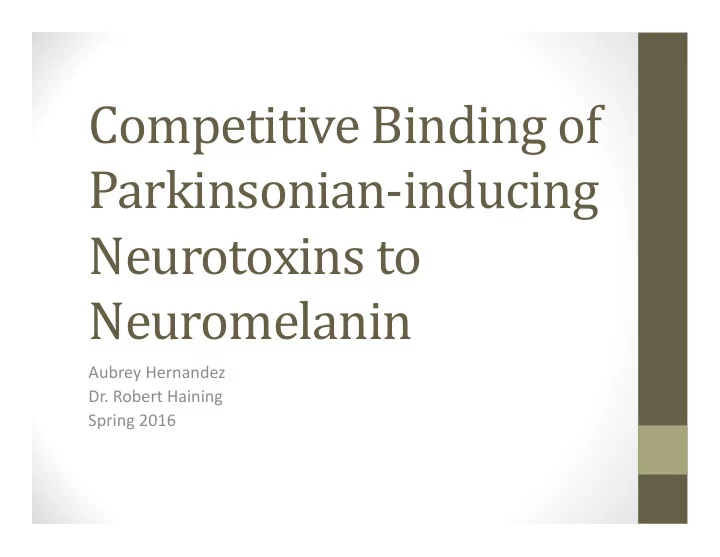

Competitive Binding of Parkinsonian‐inducing Neurotoxins to Neuromelanin Aubrey Hernandez Dr. Robert Haining Spring 2016
Parkinson’s Disease (PD) • 7 ‐ 10 million worldwide living with PD (Parkinson’s Disease Foundation, 2016) • 1 million Americans (PD Foundation, 2016) • 60,000 diagnosed each year (PD Foundation, 2016) • Age: 50+ (PD Foundation, 2016) • Symptoms: Tremors, bradykinesia, akinesia, cognition, emotions, postural instability (NIH, 2016)
Parkinson’s Disease (PD) • Death of dopaminergic neurons in substantia nigra • Dopamine can no longer reach the striatum • Causes problems with controlled movements (By NIH)
Neuromelanin (NM) • Dopaminergic neurons pigmented with neuromelanin • Hypothesized to be responsible for aiding in the controlled release of dopamine (By BruceBlaus)
Research Questions • Do neurotoxins interact directly with neuromelanin? • Can the interaction between neuromelanin and neurotoxins be disrupted by nicotine? • Is neuromelanin directly involved in the controlled release of dopamine?
Methodology • NanoDrop 3300 (Thermo Scientific, 2013) • Measures relative fluorescence under either white, UV or blue light • RFU = Relative Fluorescence Unit • Source of Neuromelanin • Synthesized in the lab following protocol from Zecca’s Neuromelanin Interaction with Lipids and Peptides (Zecca, 2002) • Fe 3+
Interaction between NM and Dopamine Under White Light 600 NM + Dopamine 500 NM NM + Dopamine 400 (Overnight) RFU 300 200 100 0 0 5 10 15 20 [Dopamine] mM
1‐methyl‐4‐phenyl‐1,2,3,6‐ tetrahydropyridine (MPTP) • Drug ‐ induced Parkinson’s disease • Converted to MPP+ • Dopaminergic uptake system/neuromelanin (D’Amato, 1986) (By Harbin)
Effect of Altering [MPTP] on Interaction between MPTP and NM Under UV Light 900 800 NM + MPTP MPTP 700 NM 600 500 RFU 400 300 200 100 0 0 5 10 15 20 [MPTP] mM
Effect of Altering [NM] on Interaction between MPTP and NM Under White Light 700 600 500 400 RFU NM + MPTP 300 MPTP NM 200 100 0 0 0.1 0.2 0.3 0.4 0.5 0.6 [NM]
Nicotine • Correlation between smokers and PD (Nefzger, 1968) • Neuroprotective effects (Singh, 2010) (By Harbin)
Interaction between Nicotine and NM Under White Light 6000 Nicotine Nic + NM 5000 NM 4000 RFU 3000 2000 1000 0 0 0.2 0.4 0.6 0.8 1 1.2 [Nic] mM
Competitive Binding of Nicotine and MPTP to NM Under UV Light 200 180 NM + Nic + MPTP 160 140 MPTP 120 RFU 100 NM + MPTP 80 60 40 20 0 0 1 2 3 4 [MPTP] mM
Competitive Binding of Nicotine and MPTP with Neuromelanin Under White Light 3000 2500 2000 RFU 1500 NM + MPTP + Nicotine NM + MPTP 1000 NM + Nicotine 500 0 0 0.1 0.2 0.3 0.4 0.5 0.6 0.7 [Nicotine] mM
Conclusion • Presence of NM causes MPTP’s RFU to disappear • Indicates interaction • Presence of nicotine causes NM RFU to increase dramatically • Indicates interaction
Conclusion • Addition of nicotine to MPTP+NM solution causes a release of MPTP back into solution • Shows nicotine can disrupt the interaction between MPTP and NM • Addition of MPTP to nicotine+NM solution doesn’t cause a change in RFU • Shows MPTP cannot disrupt the interaction between nicotine and NM
Further Experimentation • MPP+ rather than MPTP • 6 ‐ hydroxy dopamine (6 ‐ OHDA) • Chloroquine (D’Amato, 1987) and C affeine (Singh, 2010) • Shown to have neuroprotective properties • Altering [Nicotine] • Further characterize interaction between dopamine and neuromelanin
References 1. Bush WD, G. J. (2006). “The surface oxidation potential of human neuromelanin reveals a spherical architecture with a pheomelanin core and a eumelanin surface”. PNAS , 14785 ‐ 14789. 2. By BruceBlaus. When using this image in external sources it can be cited as:Blausen.com staff. "Blausen gallery 2014". Wikiversity Journal of Medicine. DOI:10.15347/wjm/2014.010. ISSN 20018762. ‐ Own work, CC BY 3.0, https://commons.wikimedia.org/w/index.php?curid=27924394 3. By Harbin ‐ Own work, Public Domain, https://commons.wikimedia.org/w/index.php?curid=5714122 4. By Harbin ‐ Own work, Public Domain, https://commons.wikimedia.org/w/index.php?curid=1629854 5. By NIH ‐ http://www.drugabuse.gov/pubs/teaching/largegifs/slide ‐ 2.gif, Public Domain, https://commons.wikimedia.org/w/index.php?curid=37682508 6. D’Amato, Robert, Guillermo Alexander, Robert Schwartzman, et al. (1987). “Neuromelanin: A role in MPTP ‐ induced neurotoxicity”. Life Sciences 40 (8): 705 ‐ 712. 7. D’Amato, ZP Lipman, and SH Snyder. (1986). “Selectivity of the parkinsonian neurotoxin MPTP: toxic metabolite MPP+ binds to neuromelanin”. Science 231(4741): 987 ‐ 989. 8. Di Monte, D.A and S.A Jewell. (2 ‐ 14). “MPTP Neurotoxicity”. Encyclopedia of Neurological Sciences 2: 131 ‐ 134. 9. Dzierzega ‐ Lecznar A, K. S. (2004). “GC/MS Analysis of Thermally Degraded Neuromelanin from the Human Substantia Nigra”. J Am Soc Mass Spectrom , 920 ‐ 926. 10. Liu Y, S. J. (2003). “Isolation and Biophysical Studies of Natural Eumelanins: Applications of Imaging Technologies and Ultrafast Spectroscopy”. Pigment Cell Res , 606 ‐ 618. 11. McGeer PL, McGeer EG. (2008). “Glial reactions in Parkinson’s disease”. Mov Disord 23, 474 ‐ 483. 12. Nefzger MD, Quadfasel FA, and Karl VC. (1968). “A retrospective study of smoking in Parkinson’s disease”. American Journal of Epidemiology 88: 149 ‐ 158. 13. Singh, Kavita, Seema Singh, Naveen Kumar Singhal, et al. (2010). “Nicotine and caffeine ‐ mediated changes in gene expression patterns of MPTP ‐ lesioned mouse striatum: Implications in neuroprotection mechanism”. Chemico ‐ Biological Interactions 185 (2): 81 ‐ 93. 14. Thermo Scientific. (2013). “NanoDrop 3300 Fluorospectrometer”. Thermo Fisher Scientific Inc. Web. 15. W, C. (2004). “The Chemical Structure of Melanin”. Pigment Cell Res , 422 ‐ 424. 16. Wakamatsu K, F. K. (2003). “The structure of neuromelanin as studied by chemical degradative methods”. J Neurochem, 1015 ‐ 1023. 17. Zecca L, T. D. (2001). “Substantia nigra neuromelanin: structure, synthesis, and molecular behavior”. Mol Pathol , 414 ‐ 418. 18. Zecca, L. et al. (2002). “Interaction of Human Substantia Nigra Neuromelanin with Lipids and Peptides”. Journal of Neurochemistry 74 (4): 1758 ‐ 1765. 19. Zecca L, Z. F. (2006). “A proposed dual role of neuromelanin in the pathogenesis of Parkinson’s disease”. NEUROLOGY , S8 ‐ S11.
Recommend
More recommend